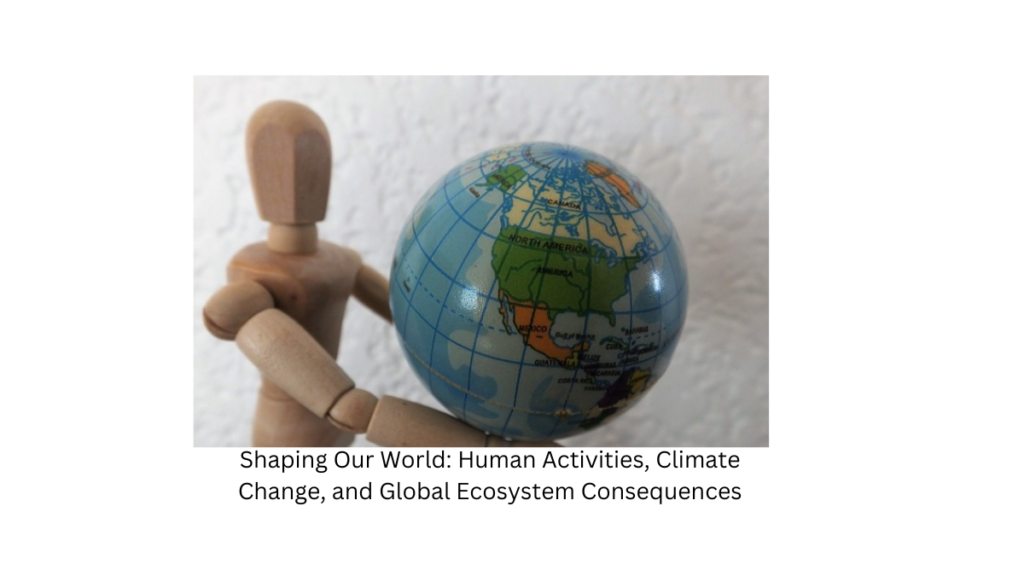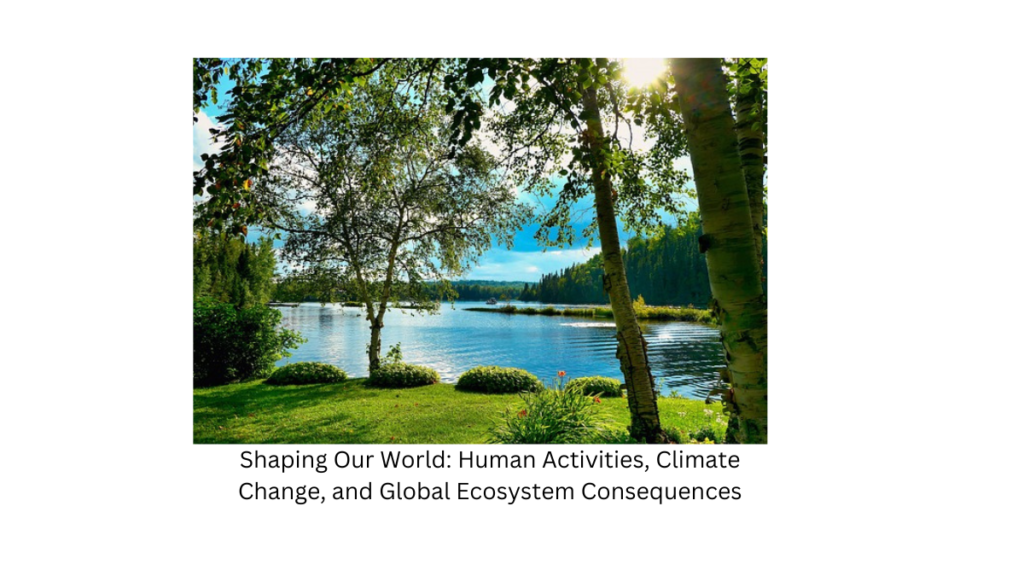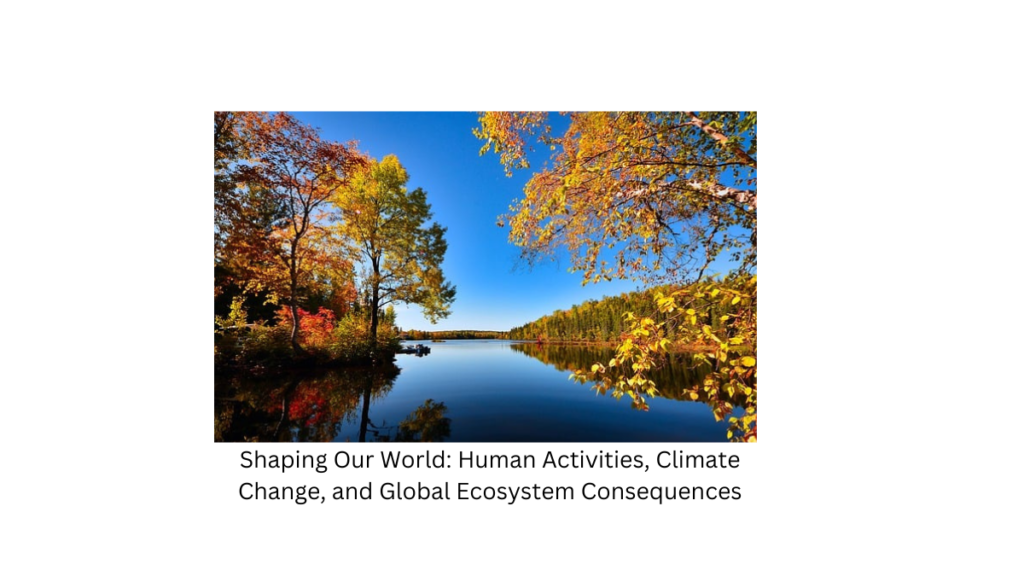Introduction:-
Shaping Our World: Human Activities, Climate Change, and Global Ecosystem Consequences

In a world driven by human advancement and progress, the impact of our actions on the environment has become a critical concern.The intricate interplay between human activities, climate change, and the resulting consequences for global ecosystems is a topic that demands attention. This article delves into the profound connection between these factors and sheds light on the intricate web of consequences that shape our world.
What is the focus of the article Shaping our world and aims to explore the complex relationships between human activities,climate change and their effects on global ecosystems?
The Human Footprint

Human activities have left an indelible mark on the planet. From deforestation to urbanization and industrialization, these actions have transformed landscapes and ecosystems in unprecedented ways. Deforestation, driven by the need for land for agriculture, settlement, and resources, has led to the loss of crucial carbon sinks – forests. These lush expanses once absorbed carbon dioxide, a major greenhouse gas, but their depletion has amplified atmospheric carbon levels, contributing significantly to global warming.
Urbanization and Its Toll
As urban areas expand to accommodate the growing global population, the repercussions are far-reaching. Urbanization leads to increased energy consumption, deforestation, and alteration of natural drainage patterns. Concrete jungles absorb and retain heat, causing localized temperature increases known as the urban heat island effect. This, in turn, disrupts weather patterns and exacerbates climate change impacts. Moreover, urbanization encroaches upon ecosystems, fragmenting habitats and threatening biodiversity. The disruption of these intricate ecosystems has consequences that ripple through the food chain and beyond.
Industrialization’s Environmental Price
Industrialization has been the driving force behind economic growth and technological advancement. However, the pursuit of progress has come at an environmental cost. The burning of fossil fuels for energy releases vast amounts of greenhouse gases, such as carbon dioxide and methane, into the atmosphere. This, coupled with deforestation and other human-driven activities, intensifies the greenhouse effect and accelerates global warming. The consequence is an array of climatic changes, including altered precipitation patterns, sea-level rise, and the increasing frequency and intensity of extreme weather events.
Unraveling Global Climate Patterns
The interconnectedness of these factors contributes to the disruption of global climate patterns. The delicate balance that once characterized Earth’s climate is now shifting, leading to phenomena such as rising sea levels and changing weather patterns. Glaciers are retreating, ice caps are melting, and oceans are warming at an alarming rate. These changes not only impact delicate marine ecosystems but also have far-reaching consequences for communities living along coastlines.
Ecosystems in Peril
Ecosystems, from rainforests to coral reefs, are intricately tied to climate patterns. The changes brought about by human activities and climate change disrupt these ecosystems, causing habitat loss, species endangerment, and even extinction. Coral reefs, for instance, are highly sensitive to temperature changes. The phenomenon known as coral bleaching occurs when stressed corals expel their symbiotic algae, leading to their death. This has dire consequences for marine life that relies on reefs for shelter and sustenance.
The Domino Effect on Biodiversity
Biodiversity, the variety of life on Earth, plays a pivotal role in maintaining ecosystem stability. Human-driven climate change threatens this biodiversity, as many species struggle to adapt to rapidly changing conditions. As certain species decline or become extinct due to habitat loss and shifting climate patterns, the intricate balance of ecosystems is disrupted. This can lead to cascading effects, where the decline of one species triggers a chain reaction that affects numerous others.
Mitigation and Adaptation
While the situation might seem dire, there is hope. Awareness of the consequences of human activities on the environment has sparked global efforts to mitigate climate change and its effects. International agreements, such as the Paris Agreement, seek to limit global warming by reducing greenhouse gas emissions. Initiatives to restore forests, adopt renewable energy sources, and promote sustainable practices are gaining momentum.
Additionally, adaptation strategies are crucial in dealing with the changes that are already underway. Communities must develop resilience to withstand the impacts of climate change. This includes designing infrastructure that can withstand extreme weather events, implementing water management strategies, and protecting vital ecosystems.
What are the consequences of climate change on Earth’s ecosystems?

The consequences of climate change on Earth’s ecosystems are wide-ranging and impactful. As temperatures rise and weather patterns shift, ecosystems around the world experience various changes that can disrupt their balance and function. Some of the key consequences include:
- Biodiversity Loss: Many plant and animal species are highly sensitive to changes in temperature and habitat conditions. As their preferred environments shift or become uninhabitable, some species might struggle to adapt or migrate, leading to a loss of biodiversity.
- Habitat Disruption: Rising temperatures and altered precipitation patterns can affect the availability of suitable habitats for various species. This can lead to habitat fragmentation, where ecosystems become isolated and disconnected, making it difficult for species to thrive.
- Species Extinctions: The combination of habitat loss, temperature changes, and disrupted food chains can increase the risk of species going extinct, especially those that are already vulnerable or have limited ranges.
- Altered Migration Patterns: Many species rely on specific cues, such as temperature changes, to trigger their seasonal migrations. Climate change can disrupt these cues, leading to mistimed migrations, which can impact species’ reproductive success and survival.
- Coral Bleaching: Rising sea temperatures can cause coral reefs to undergo a process known as coral bleaching, where the colorful algae that live within the corals are expelled, leading to weakened and more vulnerable coral structures.
- Sea Level Rise: Melting ice caps and glaciers contribute to rising sea levels. This can lead to coastal erosion, loss of coastal habitats, and increased vulnerability to flooding for both human communities and ecosystems.
- Ocean Acidification: Increased carbon dioxide levels in the atmosphere also lead to higher levels of carbon dioxide in the oceans, causing ocean acidification. This can negatively impact marine life with calcium carbonate shells or skeletons, such as coral reefs and shellfish.
- Shifts in Ecosystem Distribution: As climate zones shift, ecosystems might move to higher latitudes or altitudes to stay within their preferred temperature ranges. This can lead to competition with existing ecosystems and potential conflicts with human activities.
- Changes in Ecosystem Services: Climate change can alter the services that ecosystems provide to humans, such as water purification, pollination, and carbon storage. These changes can have far-reaching impacts on agriculture, water availability, and overall human well-being.
- Increased Wildfires and Pest Outbreaks: Warmer temperatures and altered precipitation patterns can create conditions conducive to more frequent and intense wildfires. Additionally, some pest species may thrive in warmer climates, leading to outbreaks that can harm plant and animal populations.
Overall, the consequences of climate change on Earth’s ecosystems are complex and interconnected, with cascading effects that can disrupt the delicate balance of nature. Addressing these issues requires a comprehensive understanding of the interplay between human activities, climate change, and ecosystem dynamics.
Conclusion
The intricate web of consequences resulting from human activities, climate change, and their effects on global ecosystems underscores the urgent need for collective action. The choices we make today will determine the world we leave for future generations. By recognizing the interplay between human actions and environmental impact, we can work toward a sustainable future. Through responsible practices, informed policies, and a global commitment to preserving our planet, we can shape a world that thrives harmoniously with its ecosystems.





